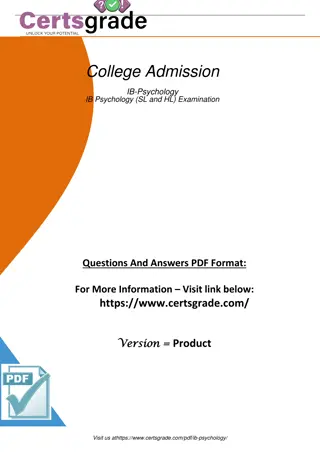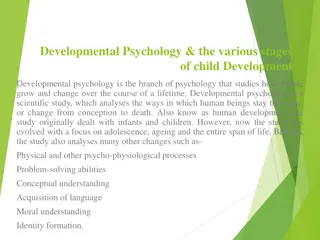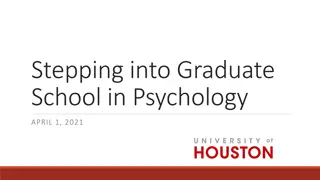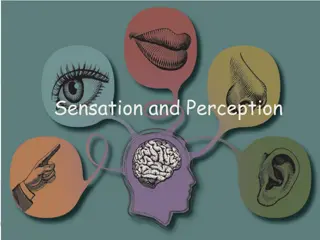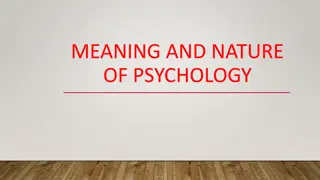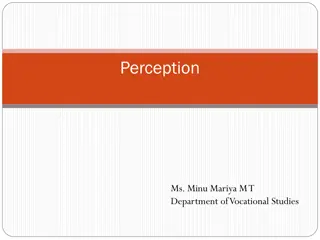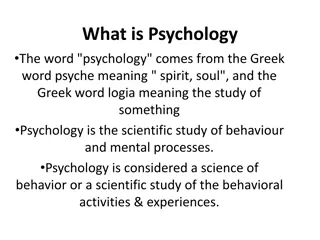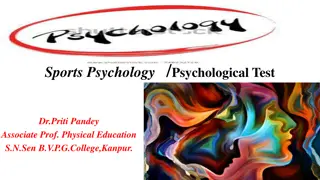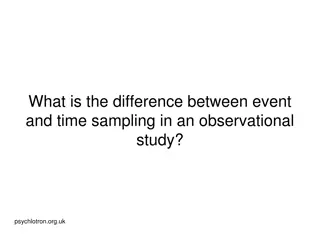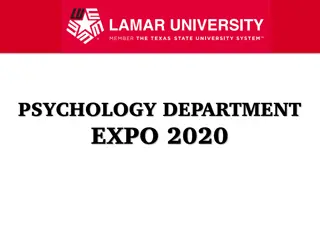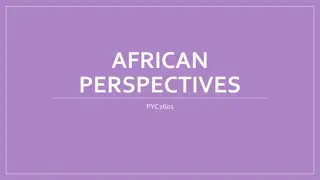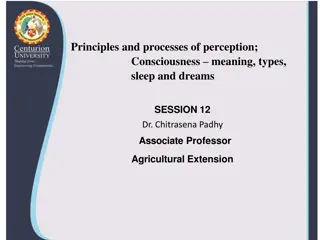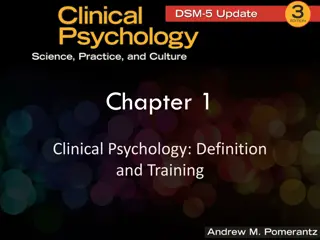Understanding Sensation and Perception in Psychology
Sensation and perception play crucial roles in how we interpret the world around us. Sensation is the process by which stimuli trigger our sensory receptors, while perception involves organizing and interpreting sensory information. This chapter delves into thresholds, sensory differences, Weber's Law, sensory adaptation, signal-detection theory, and processing stimuli. It highlights key concepts such as absolute threshold, just noticeable difference, and the ways our senses adapt and process information. Dive into the fascinating world of sensory experiences and how our minds make sense of them.
Download Presentation

Please find below an Image/Link to download the presentation.
The content on the website is provided AS IS for your information and personal use only. It may not be sold, licensed, or shared on other websites without obtaining consent from the author. Download presentation by click this link. If you encounter any issues during the download, it is possible that the publisher has removed the file from their server.
E N D
Presentation Transcript
CHAPTER 8: SENSATION AND PERCEPTION
WHAT IS SENSATION? Def: what occurs when a stimulus activates a receptor Stimulus: an aspect of or change in the environment to which an organism responds
SENSATION CONTINUED Perception: organization of sensory info into meaningful experiences Psychophysics: study of the relationships between sensory experiences and the physical stimuli that cause them
THRESHOLD Absolute threshold: the weakest amount of a stimulus that a person can detect half the time Humans have a very limited range
SENSORY DIFFERENCES Difference threshold: the smallest change in a physical stimulus that can be detected between 2 stimuli Just Noticeable Difference (JND): the smallest increase or decrease in the intensity of a stimulus that person can detect
WEBERS LAW For any change in a stimulus to be detected, a constant proportion of that stimulus must be added or subtracted A.K.A.: Weber-Fechner Law
SENSORY ADAPTATION Senses are tuned to change Senses adapt to a constant level of stimulation Necessary to ignore mundane
SIGNAL-DETECTION THEORY Def: the study of people s tendencies to make correct judgments in detecting the presence of stimuli Radar operator
PROCESSING STIMULI Preattentive process: extracting information automatically Attentive process: procedure that considers only one part of the stimuli presented at a time Stroop Interference Effect
VISION Most studied sense Pupil: opening in the iris that regulates the amount of light entering the eye Lens: flexible structure that focuses light on the Retina: innermost coating of the back of the eye, containing light sensitive receptor cells
VISION CONTINUED Cones and Rods: light receptors in the retina; convert light energy into neuronal impulses Cones: color Rods: night vision Optic Nerve: the nerve that carries impulses from the retina to the brain
COLOR DEFICIENCY Affects 8% of American men; <1% women Dysfunctional cones Red-green Yellow-blue Total deficiency: see in black and white
BINOCULAR FUSION Def: the process of combining the images received from the two eyes into a single, fused image Retinal Disparity: the differences between the images stimulating each eye Essential for depth perception
NEARSIGHTEDNESS Eyeball is longer than normal Objects focused at a point in front of the retina See objects that are near, but not far
FARSIGHTEDNESS Eyeball is too short Objects focused slightly behind the retina Distant objects are clear, near objects are not
HEARING Sound waves: vibrations in the air Loudness determined by amplitude (height) of waves Strength determined by decibels >110 decibels damages hearing
HEARING Pitch depends on sound wave frequency (rate of vibration of medium through which wave travels)
PATH OF SOUND Outer ear (pinna) receives waves Auditory canal vibrates which vibrates the ear drum Middle ear: 3 tiny bones--- hammer, anvil, and stirrup Inner ear: cochlea---liquid moves, tiny hairs detect motion, translate into neuronal input and sent to brain by the Auditory nerve
DEAFNESS 2 types: 1) Conduction deafness: hindered physical motion in the outer or middle ear Helped with conventional hearing aid 2) Sensorineural deafness: damage to the cochlea Helped with cochlear implant
BALANCE Vestibular system: 3 semicircular canals that provide the sense of balance, located in the inner ear and connected to the brain by a nerve Fluid in canals moves Hair cells translate motion
SMELL Chemical sense Gaseous molecules contact smell receptors Olfactory nerve: carries smell impulses from the nose to the brain
TASTE 5 primary tastes: 1) Sweet 2) Sour 3) Bitter 4) Salty 5) Umami (savory, meaty) Combination of these creates flavor Taste is more determined by smell
SKIN SENSES Densely bundled nerve endings create sensitivity to pressure Some are sensitive to hot and cold Pain results from many different stimuli
PERCEPTIONS OF PAIN Sharp, localized pain immediately after injury Dull, generalized pain later Gate control theory of pain: shifting attention away from pain can lessen its effects
BODY SENSES Kinesthesis: the sense of movement and body position Cooperates with vestibular system and vision Receptors in and near muscles, tendons, and joints
The way we interpret sensations and organize them into meaningful experiences SECTION 3: PERCEPTION
GESTALT Def: the experience that comes from organizing bits and pieces of info into meaningful wholes Trying to identify principles the brain uses in building perception
GESTALT PRINCIPLES 1) Proximity 2) Continuity 3) Similarity 4) Simplicity 5) Closure If elements are close to one another or similar, we perceive them as one set
FIGURE-GROUND PERCEPTION The ability to discriminate btwn a figure and its background Shows we can perceive in more than one way Works with sound as well
PERCEPTUAL INFERENCE Filling in the gaps in what our senses tell us Largely automatic and unconscious Depends on experience
LEARNING TO PERCEIVE Influenced by needs, beliefs, and expectations If we want something, we re more likely to see it Perceptual set: twisting truth to fit our own belief system
SUBLIMINAL PERCEPTION Subliminal messages: brief auditory or visual messages that presented below the absolute threshold Not really effective
MONOCULAR DEPTH CUES Can be used with a single eye Relative height: objects further away are higher on your visual plane Interposition: overlapping Light and shadows: brightly lit objects are closer
MORE MONOCULAR CUES Texture-density gradient: close objects have more detail Motion parallax: the apparent movement of stationary objects relative to one another that occurs when the observer changes position
MORE MONOCULAR CUES Linear perspective: parallel lines converge in the distance Relative motion: near objects appear to move in the opposite direction that you do; far objects seem to travel with you
BINOCULAR DEPTH CUES Depend on movement of both eyes Convergence: eyes turn inward when looking at nearby objects Retinal disparity Large disparity means close; small means far
CONSTANCY Def: the tendency to perceive certain objects in the same way regardless of changing angle, distance, or lighting
ILLUSIONS Def: perceptions that misrepresent physical stimuli Happens when perceptual cues are distorted so our brains cannot correctly interpret space, size, and depth cues



